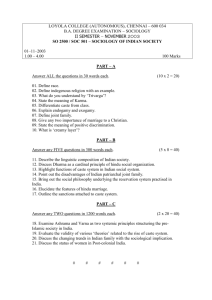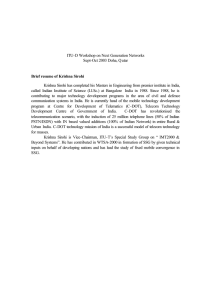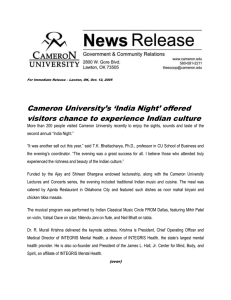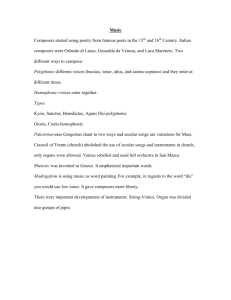Mirabai
advertisement
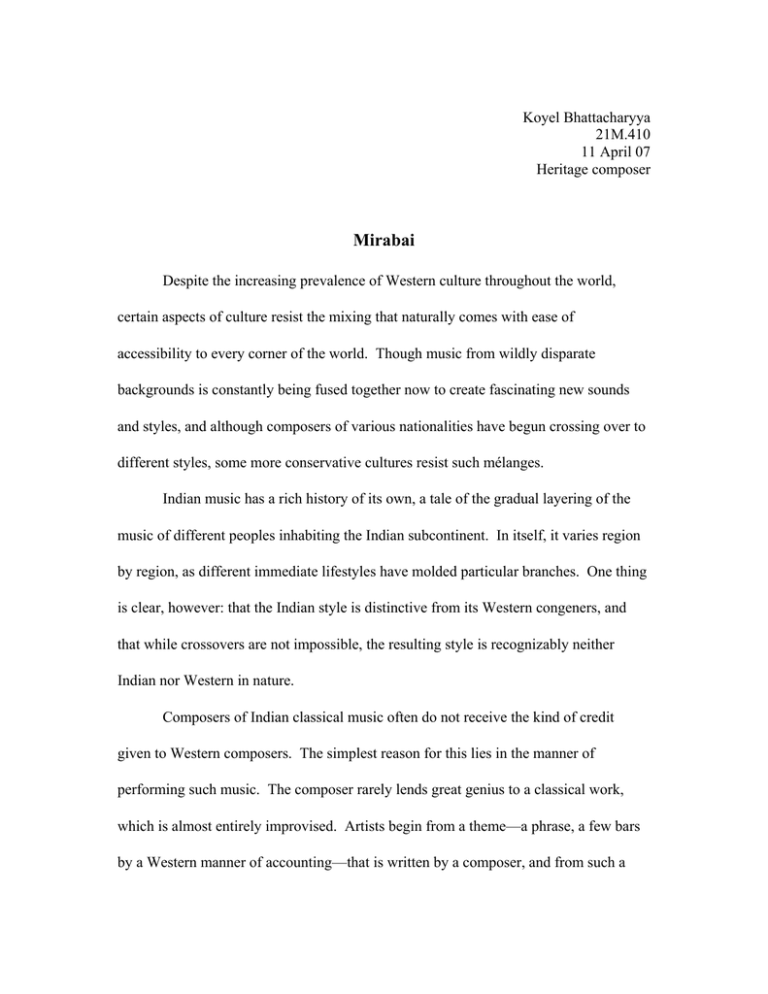
Koyel Bhattacharyya 21M.410 11 April 07 Heritage composer Mirabai Despite the increasing prevalence of Western culture throughout the world, certain aspects of culture resist the mixing that naturally comes with ease of accessibility to every corner of the world. Though music from wildly disparate backgrounds is constantly being fused together now to create fascinating new sounds and styles, and although composers of various nationalities have begun crossing over to different styles, some more conservative cultures resist such mélanges. Indian music has a rich history of its own, a tale of the gradual layering of the music of different peoples inhabiting the Indian subcontinent. In itself, it varies region by region, as different immediate lifestyles have molded particular branches. One thing is clear, however: that the Indian style is distinctive from its Western congeners, and that while crossovers are not impossible, the resulting style is recognizably neither Indian nor Western in nature. Composers of Indian classical music often do not receive the kind of credit given to Western composers. The simplest reason for this lies in the manner of performing such music. The composer rarely lends great genius to a classical work, which is almost entirely improvised. Artists begin from a theme—a phrase, a few bars by a Western manner of accounting—that is written by a composer, and from such a humble base, they build towers of melody related to the opening thematically or in melodic mode (raga). Classical pieces may last hours, as the artist explores the limits of harmonic interplay and of his own physical stamina. Because the true beauty of a work lies in its performance, then, and not in the base on which it is built, performers are more important and more widely known than composers. Compositional fame is, however, ample in the writing of poetry on which vocal music is built. These lyricists frequently set their words to music, though the music is malleable and performers are given some degree of freedom to adjust the music to their voices and styles. Entire categories of Indian music are built around such composers, leading to branches such as Rabindra sangeet (the songs of Nobel laureate Rabindranath Tagore) and Nazrul geeti (those of Kazi Nazrul Islam). Given the limited range of compositional feats that lend to fame, the tiny number of well-known female composers is unsurprising. While in many ways, the attitude of India toward women has been forward-thinking and liberating—families are historically matriarchal, and India’s first female Prime Minister, Indira Gandhi, served four decades ago—in many other ways, it has been oppressive. Less extreme than the practices of sati (self-immolation of a widow, particularly one of high class), there exist more everyday barriers for women. As in Western society, women performing outside of the home were looked upon as dirty, and a woman’s primary role was in the house, caring for her children, her husband, and their parents. As such, the proportion of female composers in Indian music is at least as small as that in Western music. One of the most famous and timeless of these is the poet-queen, Mirabai (Meera). Born in Merta in the early sixteenth century, Mirabai’s life is as much pieced together from legend and song as from fact. Her father was the ruler of Merta, and as a daughter of the privileged class, she was given a good education by her grandparents upon her mother’s death when Mirabai was four. Her education strongly stressed music, particularly—as per the tradition of the time—religious music. Though the family worshipped Vishnu as the primary deity, Mirabai quickly shifted her devotions to Krishna, the mischievous child-god avatar (incarnation) of Vishnu. According to legend, her devotion sprang from an idol given to her by a traveling beggar, in conjunction with her observation, in a previous life, of a great feat of strength and protection by Krishna. At the age of thirteen, she wed the ruler of Mewar, the highest of the kings of India at the time. Despite her social stature, Mirabai did not always follow the norms of her day. Her extreme devotion to Krishna led her to neglect many of her social responsibilities, and she rejected the family god, Durga, while dancing and singing in public temples. She also rejected the caste system, which was very much in place at the time and remnants of which still linger in Indian society today, and mingled with people of all castes and backgrounds. To these offences, she added one even greater: when her husband died a few years after their marriage, she refused to perform sati. When both her father and her dead husband’s father were killed in a war, the new ruling family of Mewar made Mirabai’s life miserable. After several attempts on her life, Mirabai left the palace and became a traveling mendicant, though she was rejected by male spiritual leaders and healers for being a woman. Her journey became a pilgrimage, and she is not said to have died so much as to have disappeared in a temple of Krishna. According to legend, she entered a Krishna temple singing in ecstasy, whereupon the doors shut behind her. Later, her sari was found entwined about the figure of Lord Krishna, a final testament to her oneness with her deity. Though Mirabai’s devotion lasted her entire life, she composed most prolifically after being forced out of her deceased husband’s palace. As many as 1300 pieces are attributed to her, though her original texts have since been translated into various languages, primarily Hindi. She wrote mostly of her love for Krishna and of her gratefulness for his graces, and during her lifetime, she frequently performed her own works, accompanying herself on a sitar given to her by a member of the “untouchable” caste whom she held in high esteem as an enlightened fellow devotee of Krishna. Her fame spread throughout India, not only for her compositions, but also for her skill at singing, as well as for her strange history. Her scandals in court of abandoning the ways of royals in order to be closer to Krishna were looked upon more favorably by the people, with whom she mingled regardless of caste or wealth. Indeed, she did much to erase caste boundaries and to defy the roles set for women, by refusing to commit sati and by refusing to obey the rules of propriety. Her work to advance social norms through her own actions and through her music has endured until today. Her music is typically simple of rhythm, its power lying in the support of the text by the music. Like most Indian vocal music, the composer pays little attention to accompaniment, with the instrument (typically, sitar or harmonium) and tabla (drums) improvising in a way that lends the strongest foundation to the vocalist. The voice itself is given great flexibility, and ornamentation and undisruptive text painting are frequent. Mirabai’s melodies are repetitive, coming in the form of a refrain intercalated between short verses, and the meaning of the text in each verse lends different parts of her songs their disparate feelings. Again as in most Indian music, her melodies are modal (in various ragas), often lending them a mystical air. Her pieces have been remarkably preserved, and are collectively known as Padavali. One of her most popular pieces, transliterated to “Payoji Maine” (“I have found”) runs as follows: Payo ji maine Rama-ratana dhana payo. (refrain) I have found, yes, I have found the wealth of the Divine Name's gem. Vastu amolika di mere sataguru, kirpa kara apanayo, payo ji maine... My true guru gave me a priceless thing. With his grace, I accepted it. Janama janama ki puji pai, jaga me sabhi khovayo, payo ji maine... I found the capital of my several births; I have lost the whole rest of the world. Kharaca na khute, cora na lute, dina dina barhata savayo, payo ji maine... No one can spend it, no one can steal it. Day by day it increases one and a quarter times. Sata ki nava khevatiya sataguru, On the boat of truth, the boatman was my bhava-sagara tara ayo, payo ji maine... true guru. I came across the ocean of existence. Mira ke Prabhu Ghiridhara Nagara, harasha harasha jasa gayo, payo ji maine... Mira's Lord is the Mountain-Holder, the suave lover, of whom I merrily, merrily sing. This piece is characteristic of Mirabai’s pieces. Again an artifact of most Indian vocal music, particularly of the older variety, Mirabai inserts herself into the final verse of the song (Mira ke Prabhu…), much as an artist signs a canvas. She emphasizes in that final verse her devotion to Krishna (the Mountain-Holder, as per legend), and though much of the beauty is lost in translation, one can still understand the innocent love of a disciple for her master. Mirabai’s stature and fame preserved her name and her works through the centuries, making her one of the best-documented and most widely-renowned Indian composers of either gender. That she, as a woman, accomplished so much makes her an even greater anomaly, a stand-out among stand-outs. The purity of her devotion caused her great troubles and pain throughout her life, as she was persecuted for her love for her deity and his other disciples, regardless of caste. At the same time, it allowed her an outlet for the beauty we see in her pieces, and made her one of the greatest composers of Indian music. References Behari, Bankey. 1971. Bhakta Mira, 2nd ed. Bombay, Bharatiya Vidya Bhavan. Harlan, Lindsey. 1992. Religion and Rajput Women: The Ethics of Protection in Contemporary Narratives. University of California Press, Berkeley. Hawley, John Stratton; Wulff, Donna Marie, ed. 1986. The Divine consort: Radha and the goddesses of India. Boston: Beacon Press. Rosen, Steven J. 1996. Vaisnavi: Women and the Worship of Krishna. Delhi: Motilal Banarsidass Publishers.

